Top News
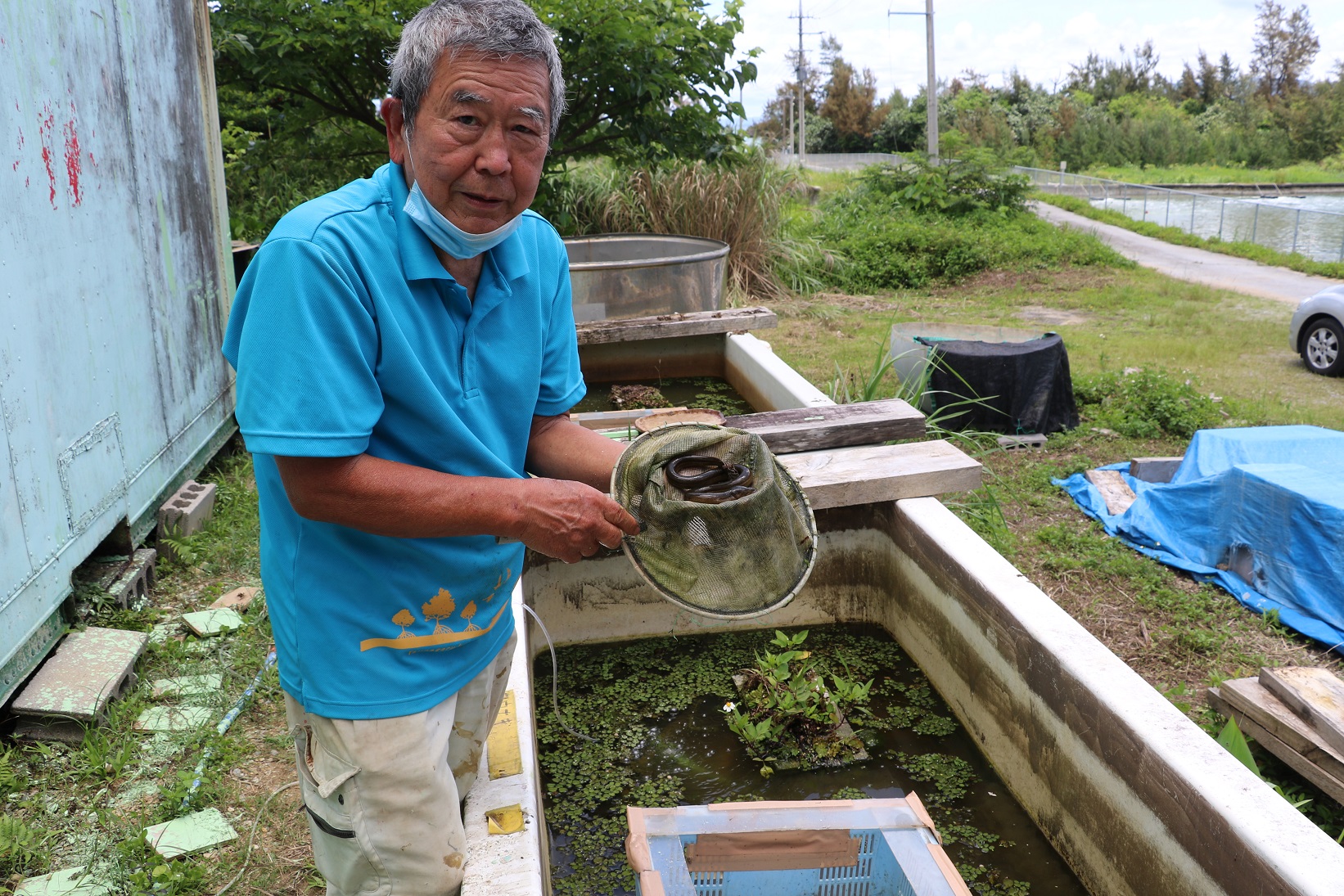
May 31, 2020 Ryukyu Shimpo
By Masayasu Minei
Yaga, Nago City—Nowadays, it is rare to see native species of tadpoles (takamah-mi in the Okinawan language), crucian carp (tah-iyu), stag beetles, and horned beetles; but Makoto Zamami, 70, has bred and propagated generations of these freshwater creatures and insects as a long-time hobby. He breeds aquatic creatures like tadpoles, crucian carps, betta fighting fish (toh-iyu in Okinawan) and Asian swamp eels (toh-nah-ja), weather loaches, and several insect species including the Okinawanus Sakaino beetle and the Yaeyama beetle.
Zamami moved to Nago City from Shuri, Naha City, 40 years ago to breed prawns. He encountered health issues in his fifties, which shifted his perspective on life. He gave up his 28-year-old prawn business and began breeding the insects and freshwater fish he had loved since childhood. These days, Zamami and his breeder friends of the insect club Ichimushi Kai give away mature fish and insects to local children and elementary schools.
Zamami laughed as he said, “It’s tough because I spend my pension on feed and breeding. But I just want the children to nurture a curiosity and interest in small creatures and preserving these species.”
Ichimushi Kai will be giving away free tadpoles and stag beetle larvae at the Makiya Undou Hiroba parking lot in a drive-thru format between 10 a.m. and 4 p.m. on June 14.
Call Zamami at 090-3793-3896 for more details.
(English translation by T&CT and Monica Shingaki)
go to japanese

May 29, 2020 Ryukyu Shimpo
On May 28 it came to light that, in March of this year, the Okinawa Defense Bureau (ODB) ordered additional construction projects for the land reclamation work on the Futenma Replacement Facility (FRF) in Henoko, Nago City, thereby increasing the original cost of contracts by a total of approximately 13.5 billion yen. Soil deposits started in just two project areas, zones “(2)-1” and “(2)”. However, since 2017 a total of six construction projects have been ordered, and these construction costs have reached 51.3 billion yen.
Land reclamation work is currently advancing on the shore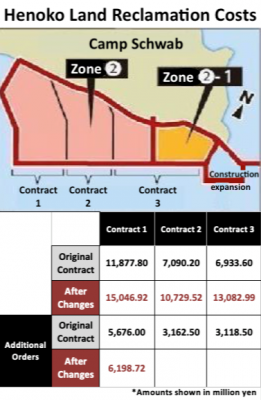 in Henoko. The ODB separated the two zones into three project areas and, in 2017, placed construction project orders. Even since 2017, contract changes have piled up.
in Henoko. The ODB separated the two zones into three project areas and, in 2017, placed construction project orders. Even since 2017, contract changes have piled up.
In March of this year three construction projects were ordered, and these projects will require further soil deposits and more land reclamation sites. One of these projects immediately changed a contract, and the contract sum increased from 5,676 million yen to 6,198.72 million yen.
The zones are in following with 2017 construction, but the contracts are divded into three projects. One vendor that accepted a portion of the additional orders is a joint venture that is currently handling construction under the 2017 contract.
(English translation by T&CT and Erin Jones)
go to japanese
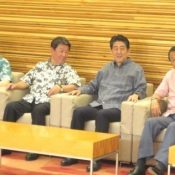
May 28, 2020 Ryukyu Shimpo
Tokyo – The Japanese government decided to cancel an annual cabinet meeting where the cabinet members all wear Kariyushi shirts in what has been dubbed the “Kariyushi Cabinet Meeting” May 27.
This year’s meeting was cancelled both due to the effects the coronavirus itself, as well as a notification sent my Okinawa Prefecture to the prime minister that they will not be able to send their annual gift of Kariyushi shirts as they try to stem the spread of the coronavirus.
The “Kariyushi Cabinet Meeting” took place even after the Tohoku earthquake in 2011, with all the cabinet members appearing in their colorful shirts.
(English translation by T&CT and Sam Grieb)
go to japanese
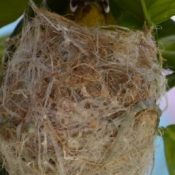
May 29, 2020 Ryukyu Shimpo
Chatan – A Japanese white-eye built its nest in Zenkei Yonaha’s satsuma orange tree in Chatan, Chatan Town. Three baby birds had hatched by May 27. Yonaha uses a parasol or branches to cover and protect the nest while the parents are off searching for food. “I worry about the nest every day because of the heavy rain during rainy season,” he says, sounding like a parent bird himself.
According to Yonaha, the nest was completed in early May. Peeking into the nest revealed three eggs. The eggs hatched on May 23, 24, and 27th, one egg each day. Occasionally, the peep-peep of the chicks’ songs can be heard from the nest.
With the tree’s lush foliage, it can be difficult to see what is going on in the nest. Yonaha tries to create a safe environment for the baby birds when the parents are away, for example by securing branches that seem likely to snap. Yonaha says, “Once in a while you can see the chicks. They’re very cute. I want them to grow up safely.” He is looking forward to seeing the baby birds leave the nest.
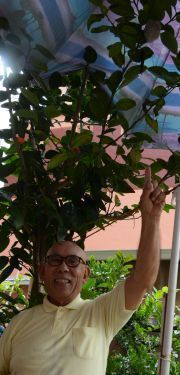
Zenkei Yonaha smiles as he watches over the Japanese white-eye chicks in the nest built in the satsuma orange tree in his garden (May 28, Chatan, Chatan Town)
(English translation by T&CT and Ellen Huntley)
go to japanese

May 23, 2020 Ryukyu Shimpo
Sometime before May 22, the Okinawa Defense Bureau found that the crested serpent eagle, a nationally protected species, is nesting at the future site of the Japan Ground Self-Defense Force base in Hirae-oomata, Ishigaki City. Subsequently, the bureau suspended construction at the site indefinitely on May 20.
The male bird of a presumed couple was observed transporting food and traveling to and from one specific location during an environmental monitoring survey conducted on May 20.
The Defense Bureau said it will take input from the city and experts under advisement to implement necessary conservation measures and proceed with construction appropriately.
Similarly, last year the use of heavy machinery at the Hirae-oomata construction site was suspended for a one-month period beginning at the end of April (it spanned the long holidays) after the crested serpent eagle was observed nesting at the site.
(English translation by T&CT and Monica Shingaki)
go to japanese

May 26, 2020 Ryukyu Shimpo
By Chie Tome
(Kadena) Ensuring good ventilation is an important measure to prevent the spread of infection of the novel coronavirus, but residents of Kadena Town, Okinawa, who live side by side with the U.S. military’s Kadena Air Base, where aircraft engage in takeoff and landing at all hours of the day and night, can’t even open their windows. “I want to open my windows, but the noise and awful smells are too much to bear.” “My income fell drastically this month, but my electricity bill is going through the roof.” More and more residents say they are in dire straights now that they spend most of their time at home during this time of social distancing.
There were 85 complaints made from April 1 to May 15, most concerning noise and foul smells.
Town Councilman Iwao Teruya of Yara, Kadena, who lives quite near the base, has also heard many grievances from local residents. During the Golden Week holiday, unable to go out, he thought he would at least give his children the experience of camping out on a tent on the roof of his home, but the engine noise and smells, which started at 6 a.m., were too much to bear and they had to go back inside. “It’s noisy even when we’re indoors, and mentally it’s very hard. Everyone living around here is suffering,” he said.
“There are announcements around town telling us to open our windows, but it would be impossible live with them open,” said a woman in her twenties who lives in Mizugama, Kadena. She explained that she hasn’t been able to go to her job because of coronavirus, and her income has decreased drastically. “I have very active kids, so we leave the air conditioner on all the time. I’m afraid my electricity bill next month will be double the usual amount,” she said with a sigh, expressing her wish just to be able to breath some fresh air.
(English translation by T&CT and Sandi Aritza)
go to japanese

May 25, 2020 Ryukyu Shimpo
By Kotaro Nagamine
In order to provide some energy for the children who are still stuck at home from school due to the coronavirus Naha’s Tomari Elementary School teacher Bunshiro Nagamine, 43, has been uploading “Radio Karate” videos to YouTube. In the videos, Nagamine has donned a karate mask and demonstrates karate fundamentals such as fukyu kata 1 in rhythm to stirring music.
Radio karate is traditional Okinawa karate paired with music and a voiceover providing instructions, a fun instructional exercise similar to Japan’s radio calisthenics. Nagamine is the third generation owner of the World Matsubayashi-ryu (Shorin-ryu) Karate-do Association’s Kodokan Nagamine Karate Dojo, and is a 3rd Dan black belt. His grandfather, Shoshin, was the founder of Matsubayashi-Ryu Karate. “Karate is not just for competitions, it can be used as a lifelong pursuit that promotes health, and I want to share this with the children.” Based on this idea, Nagamine started doing radio karate around seven years ago.
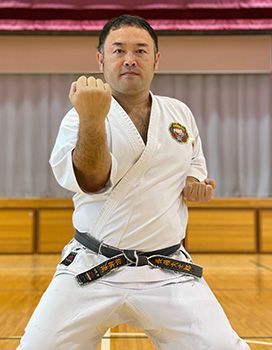
Tomari Elementary School teacher Bunshiro Nagamine performing karate without his “Karate Mask”
Due to school’s being closed, children have had the daily rhythm of their lives disrupted, and he decided to upload the videos to help children stay in shape.
The children at Tomari Elementary do radio karate before the morning meeting. The students have responded with things like, “It gives me some spirit from the morning and I feel good,” and “I am proud that I can do karate.”
School principal Masatoshi Dana said, “Radio karate is a fun way to enjoy traditional culture, and it is useful in nurturing children.” Tomari Elementary re-opened to students on May 21. Nagamine said, “I want to have classes quickly, however I am still worried about the spread of the virus. I want them to use radio karate to boost their constitutions and bolster their immune systems.”
Radio karate has also been posted on the Tomari Elementary School homepage. It also started broadcasting on FM Naha at 6:30 a.m. every morning starting May 13, turning it into a bona fide “Radio Karate.”
(English translation by T&CT and Sam Grieb)
go to japanese

May 24, 2020 Ryukyu Shimpo
By Takahiro Kina
Nakijin, Okinawa—The Nakijin Agu pork may disappear as sales have been disrupted by the novel coronavirus outbreak and its producer faces a business crisis. Nakijin Agu is said to be the only breed of pigs native to Okinawa, and unlike other Agu breeds, has a lineage originating in Asia. Founded 20 years ago to preserve the Nakijin Agu breed as a biological resource, the Nakijin Agu Agricultural Production Cooperative (chaired by Masaru Takada) says the swine fever outbreak followed by the coronavirus pandemic affected demand from local and outside hotels, causing a sharp drop in revenue.
Most commonly-consumed improved breeds of hogs mature to market weight at 6 months of age, but Nakijin Agu pigs are shipped at 18 months. Nakijin Agu pigs are also very expensive to raise, as they are fed premium feed like rice, locally produced dried tuna powder, and awamori mash vinegar, instead of genetically modified corn or soybeans. Its premium-quality,
Takada, who is currently raising 354 pigs, explained: “Preserving the Nakijin Agu breed is made possible by consumer demand.” He said, “The business is in an impossible situation. The feed and maintenance costs have piled up during the pandemic, and the breed is currently facing extinction.”
Takada made some emergency sales in April to make cash for feed, however it was not enough to revive the business.
He has created a crowdfunding page online, where he hopes to raise 6 million yen.
Takada said, “I hope to overcome this difficulty somehow; it’s not just about the business, it’s also about saving a piece of culture and a biological resource. Producers cannot preserve a breed alone, we need people to support us by consuming them.”
Scan the QR code below to make a donation today.

(English translation by T&CT and Monica Shingaki)
go to japanese
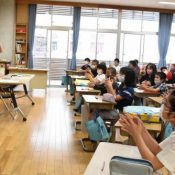
May 21, 2020 Ryukyu Shimpo
Okinawa – On May 21, elementary and middle schools in Okinawa Prefecture reopened after a continued school closure due to the spread of novel coronavirus. At Misato Elementary School in Okinawa City, energetic children arriving at school in a light rain were warmly welcomed by teachers. Returning students celebrated reunions. New students seemed somewhat nervous.
Satomi Kanzato, homeroom teacher for class 1-2, asks her first graders “Who couldn’t wait to come back to school?” Every hand shoots up accompanied by shouts of “Me!” Ms. Kanzato tells her students, “I want us to take good care of our well-being and do our very best to be upfront with each other.” After first hour ends, Yoshimaru Ogawa, a fifth grader, says, “I finally get to see everyone. I’m glad we can be in class together.”
Principal Kiyomi Ikemiyagi says, “It feels like coming home. I’m proud of everyone for enduring until now.” Explaining how the school will operate going forward, she says, “I want us to make sure that we are careful to wash our hands, gargle, and wear our masks.”
As children arrived at school, teachers could be seen in the entryway, making sure students were wearing their masks. As a way to prevent the spread of infection, every class started first hour with an explanation of hand-washing. Teachers showed students a video on the screen to ensure every child completely understood how to wash their hands.
To help students learn social distancing, footprint stickers were placed at appropriate intervals in the halls. Teachers also explained in class. Spare tissues and hand soap that students brought from home were placed in each classroom.
(English translation by T&CT and Ellen Huntley)
go to japanese
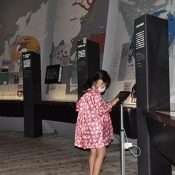
May 22, 2020 Ryukyu Shimpo
The Peace Memorial Museum in Itoman City, Okinawa, reopened its doors on May 21. The museum has been temporarily closed on-and-off since mid March, due to the novel coronavirus outbreak. Group tours of the permanent exhibition will be unavailable at this time, to prevent the “3Cs”—closed spaces, crowds, and close proximity. The daily average visitor last May was approximately 1,455 but turnout was drastically low on reopening day. Just one month before Okinawa Memorial Day, COVID-19 may dampen active peace education imparting the history of WWII.
“Please keep at least 2 meters apart,” a museum worker instructed as he ripped tickets. The visitors are asked to wear masks, disinfect hands upon entry, and to stay 2 meters apart.
7-year-old Yurika Miyagi visited from Ginowan City with her mother and grandmother on reopening day. “I wanted to learn [the history],” she said shyly. The family anticipated a low turnout and decided to visit the museum, just a day before Yurika’s new-student orientation at school.
In the exhibition rooms, the emergency doors were left open and group tours were cancelled to prevent the “3Cs”. The Memorial Hall and other large conference rooms used for peace education lectures will be closed until May 31. This may continue after June, depending on the situation.
Once group tours resume, the museum is expecting to set a maximum number of visitors allowed in each exhibition, to prevent crowding.
Hiromu Ohmine, the museum’s lead curator, hopes to provide opportunities to learn about the Battle of Okinawa with the educational kits and video materials he created. The kits are available in the museum, and schools are able to rent them for classroom use. Ohmine said, “Anytime is a good time to ponder peace.”
(English translation by T&CT and Monica Shingaki)
go to japanese
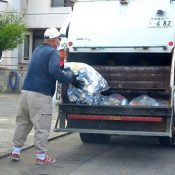
May 21, 2020 Ryukyu Shimpo
By Shinji Sano
Miyakojima – Every morning, at the same time with the same music, the garbage collection truck races around town. While most of society has stopped working or is working remotely due to the spread of COVID-19, sanitation workers have continued to collect trash without a single day of vacation. “Thinking about the risk of infection for myself and my family is scary. But, it doesn’t mean we can take time off.” The pride taken by those who work to maintain people’s everyday lives is vital support for everyone’s ability to stay at home.
Early in the morning on May 11, one of the garbage collection trucks that drives around Miyakojima has two riders wearing masks, sunglasses, and rubber gloves. The two collect garbage, taking turns as driver and collector. They turn off the main street, and just when you think they’ve gone down one side-street, they are already turning around and heading down another.
One of the sanitation workers, Yasuhiro Yonaha, 46, said smiling, “The route is intricate like a spider’s web. There is a process to collecting all of the garbage efficiently. It is not something that can be done in a day.”
It’s not just the route. House waste in Miyakojima is divided into four categories: burnable, recyclable, bulk, and yard waste. The workers use their eyes, hands, and intuition to determine what type of garbage the bags contain. This all happens in less than a second.
There are 29 employees who operate a fleet of 30 garbage collection vehicles around the city each day.
Kazuyuki Shimoji, 40, who collects burnable waste, boasts, “Due to the risk of contamination, even though some may think we are just here to carry the garbage, this is a specialized profession that we could not ask someone to do for us.”
There have also been times where people have gotten angry when they are told that the trash cannot be collected if it has not been properly separated. As the coronavirus progresses, there has also been an increase in the number of masks found in the garbage. “I only briefly see my family’s faces in passing. It’s scary to think about, but we have a responsibility to properly collect the garbage.”
Because they “would not ask someone to do [the job] in our place,” they never take days off. Yonaha says that the reason they aren’t taking breaks is to show gratitude to the people of the city. “The city has been working to improve the labor conditions for sanitation workers. The number of collection contracts has also increased this year. This is all paid for by people’s taxes. For that we are grateful, and so we must carry out our duties.”
Recently, people have been placing food for the workers at collection sites, as well as masks for the workers to use. The two sanitation workers said smiling, “We are really grateful, and we want to reciprocate those kind thoughts. It is an honor to collect your garbage.”
(English translation by T&CT and Sam Grieb)
go to japanese

 in Henoko. The ODB separated the two zones into three project areas and, in 2017, placed construction project orders. Even since 2017, contract changes have piled up.
in Henoko. The ODB separated the two zones into three project areas and, in 2017, placed construction project orders. Even since 2017, contract changes have piled up.












 Webcam(Kokusai Street)
Webcam(Kokusai Street)


